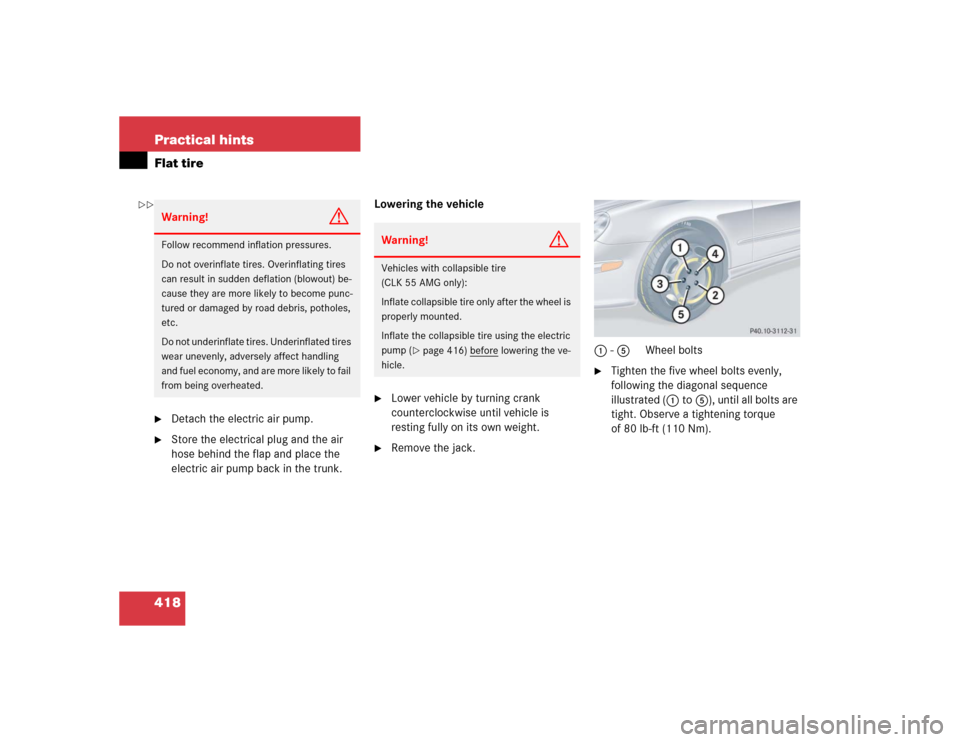Page 308 of 498
306 OperationAt the gas station�
Replace fuel cap by turning it
clockwise.
You will hear when the fuel cap is
tightened.
�
Close fuel filler flap.Warning!
G
Overfilling of the fuel tank may create
pressure in the system which could cause a
gas discharge. This could cause the gas to
spray back out when removing the fuel
pump nozzle, which could cause personal
injury.
iOnly use premium unleaded gasoline
with a minimum Posted Octane Rating
of 91 (average of 96 RON / 86 MON).
Information on gasoline quality can
normally be found on the fuel pump.
For more information on gasoline, see
“Premium unleaded gasoline”
(�page 450) or the Factory Approved
Service Products pamphlet.
iLeaving the engine running and the fuel
cap open can cause theú malfunc-
tion indicator lamp (USA only) or
the± malfunction indicator lamp
(Canada only) to illuminate.
More information can be found in the
“Practical hints” section (
�page 356).
��
Page 420 of 498

418 Practical hintsFlat tire�
Detach the electric air pump.
�
Store the electrical plug and the air
hose behind the flap and place the
electric air pump back in the trunk.Lowering the vehicle
�
Lower vehicle by turning crank
counterclockwise until vehicle is
resting fully on its own weight.
�
Remove the jack.1 - 5Wheel bolts
�
Tighten the five wheel bolts evenly,
following the diagonal sequence
illustrated (1to5), until all bolts are
tight. Observe a tightening torque
of 80 lb-ft (110 Nm).
Warning!
G
Follow recommend inflation pressures.
Do not overinflate tires. Overinflating tires
can result in sudden deflation (blowout) be-
cause they are more likely to become punc-
tured or damaged by road debris, potholes,
etc.
Do not underinflate tires. Underinflated tires
wear unevenly, adversely affect handling
and fuel economy, and are more likely to fail
from being overheated.
Warning!
G
Vehicles with collapsible tire
(CLK 55 AMG only):
Inflate collapsible tire only after the wheel is
properly mounted.
Inflate the collapsible tire using the electric
pump (
�page 416) before
lowering the ve-
hicle.
��
Page 453 of 498

451 Technical data
Fuels, coolants, lubricants, etc.
Fuel requirements
Only use premium unleaded fuel:�
The octane number (posted at the
pump) must be 91 min. It is an average
of both the Research (R) octane num-
ber and the Motor (M) octane number:
(R+M) / 2). This is also known as the
ANTI-KNOCK INDEX.
Unleaded gasoline containing oxygenates
such as ethanol, IPA, IBA and TBA can be
used provided the ratio of any one of these
oxygenates to gasoline does not
exceed 10%; MTBE not to exceed 15%.
The ratio of methanol to gasoline must not
exceed 3% plus additional cosolvents.
Using mixtures of ethanol and methanol is
not allowed. Gasohol, which contains 10%
ethanol and 90% unleaded gasoline, can be
used.
These blends must also meet all other fuel
requirements, such as resistance to spark
knock, boiling range, vapor pressure, etc.
Gasoline additives
A major concern among engine manufac-
turers is carbon build-up caused by gaso-
line. Mercedes-Benz recommends only the
use of quality gasoline containing additives
that prevent the build-up of carbon depos-
its.
After an extended period of using fuels
without such additives, carbon deposits
can build up especially on the intake valves
and in the combustion area, leading to en-
gine performance problems such as:�
Warm-up hesitation
�
Unstable idle
�
Knocking/pinging
�
Misfire
�
Power lossIn areas where carbon deposits may be en-
countered due to lack of availability of gas-
olines which contain these additives,
Mercedes-Benz recommends the use of
additives approved by us for use on
Mercedes-Benz vehicles. Refer to Factory
Approved Service Products pamphlet for a
listing of approved product(s). Follow di-
rections on product label.
Do not blend any specific fuel additives
with fuel. This only results in unnecessary
cost and may be harmful to the engine
operation.
Damage or malfunction resulting from
poor fuel quality or from blending addition-
al fuel additives other than those tested
and approved by us for use on
Mercedes-Benz vehicles listed in the
Factory Approved Service Products pam-
phlet are not covered by the
Mercedes-Benz Limited Warranty.
Page 459 of 498

457 Technical terms
Instrument cluster
The displays and indicator/warning
lamps in the driver’s field of vision, in-
cluding the tachometer, speedometer,
coolant temperature and fuel gauge.
KEYLESS-GO*
System for entering and operating the
vehicle without the use of a SmartKey.
Kickdown
Depressing the accelerator past the
point of resistance shifts the transmis-
sion down to the lowest possible gear.
This very quickly accelerates the vehi-
cle and should not be used for normal
acceleration needs.Line of fall
The direct line that an object moves
downhill when influenced by the force
of gravity alone.
Lock button
Button on the door which indicates
whether the door is locked or un-
locked. Pushing the lock button down
on an individual door from inside will
lock that door.
Maintenance System (U.S. vehicles)
Maintenance service indicator in the
multifunction display that informs the
driver when the next vehicle mainte-
nance service is due. The Maintenance
System in your vehicle tracks distance
driven and the time elapsed since your
last maintenance service, and calls for
the next maintenance service
accordingly.Memory function*
Used to store three individual seat,
steering wheel and mirror positions for
each SmartKey or, if so equipped,
KEYLESS-GO* feature.
Menu
The control system displays are ar-
ranged in menus. Each menu contains
a number of commands for particular
systems.
MON
(M
otor O
ctane N
umber)
The Motor Octane Number for gasoline
as determined by a standardized meth-
od. It is an indication of a gasoline's
ability to resist undesired detonation
(knocking). The average of both the
MON (Motor Octane Number) and
->RON (Research Octane Number) is
posted at the pump, also known as
ANTI-KNOCK INDEX.
Multifunction display
Display field in the speedometer used
to present information provided by the
control system.